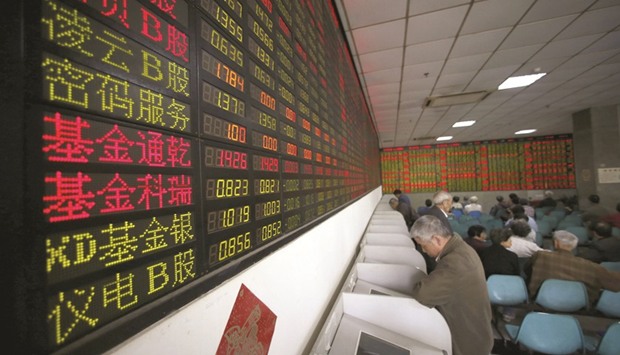In a Chinese stock market where superstition and government intervention often count for more than economic fundamentals, unusual trading patterns are par for the course.
But even by China’s standards, the latest market anomaly to grab the attention of local investors stands out.
The Shanghai Composite Index, notorious for its wild swings over the past two years, has gone 85 trading days without a loss of more than 1% on a closing basis, the longest stretch since the market’s infancy in 1992.
On 13 days during the streak, the index recovered from intraday declines exceeding 1% to close above that threshold. The phenomenon has been especially stark recently, with the gauge erasing about half of its 1.6% drop in the final 90 minutes of trading last week. For some investors, it’s a sign that state-directed funds are putting a floor under daily market swings – a development that presents short-term buying opportunities when the Shanghai Composite dips more than 1% during intraday trading.
The theory may have merit: China’s securities regulator has this year sought to stabilise the stock market by limiting the extent of declines in the Shanghai Composite, according to people familiar with the strategy, who asked not to be identified discussing a matter that hasn’t been disclosed publicly.
“There is room for arbitrage in the short term,” said Zhang Haidong, a money manager at Jinkuang Investment Management in Shanghai.
The China Securities Regulatory Commission didn’t immediately respond to a faxed request for comment. The Shanghai Composite rose less than 0.1% on Thursday, rebounding from an intraday loss of as much as 0.7%. To be sure, market anomalies like this one rarely last.
Over the past few years, Chinese stocks have gone through several short-lived phases – everything from bouncing off key index levels to slumping in the early afternoon to rallying into the close. Each time, the pattern eventually faded.
The Shanghai Composite’s current resilience could also be explained by global factors. Equity volatility has dropped around the world this year, with the MSCI Emerging Markets Index sliding more than 1% just four times since mid-December.
“I don’t think it’s the national team supporting the market,” said Hao Hong, chief strategist at Bocom International Holdings Co in Hong Kong, referring to the local nickname for state-run funds. “Volatility around global markets is down.”
The “bearish trend” in Chinese stocks isn’t over, Hong said. Despite avoiding big daily losses, the Shanghai Composite has retreated for four straight days and is down 3.6% from this year’s high on April 11.
Still, some investors are convinced the government will act to prop up share prices. CSRC Chairman Liu Shiyu said last year that the state will intervene “decisively” if needed to bolster the market, while stability has been a key focus of policy makers in 2017 as the ruling Communist Party prepares for a twice-a-decade leadership reshuffle toward year-end.
Authorities favour a steady stock market because it helps companies fund investment and repay debt by issuing new shares, which could help boost economic growth, according to Yin Ming, a vice-president at Baptized Capital in Shanghai.
“The national team is behind it,” Yin said. “State funds will likely continue to be a market stabiliser.”

Investors look at computer screens showing stock information at a brokerage house in Shanghai. The Shanghai Composite Index, notorious for its wild swings over the past two years, has gone 85 trading days without a loss of more than 1% on a closing basis, the longest stretch since the market’s infancy in 1992.
